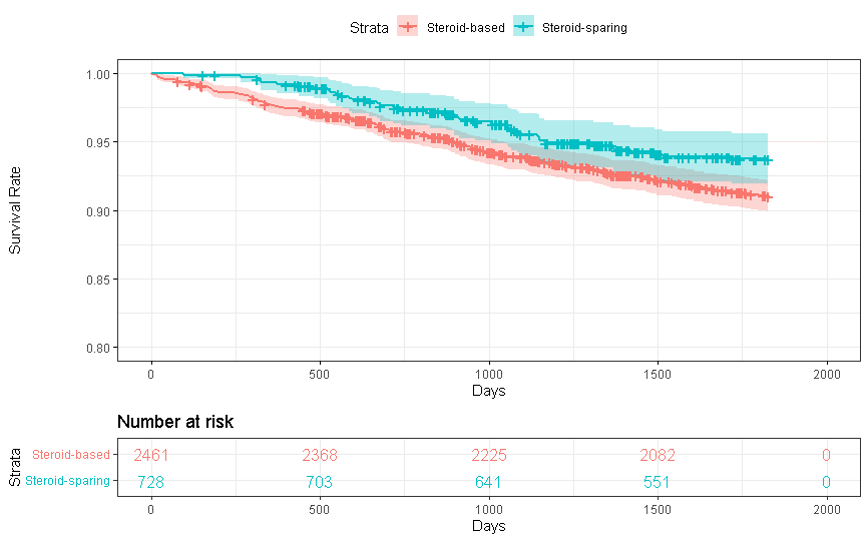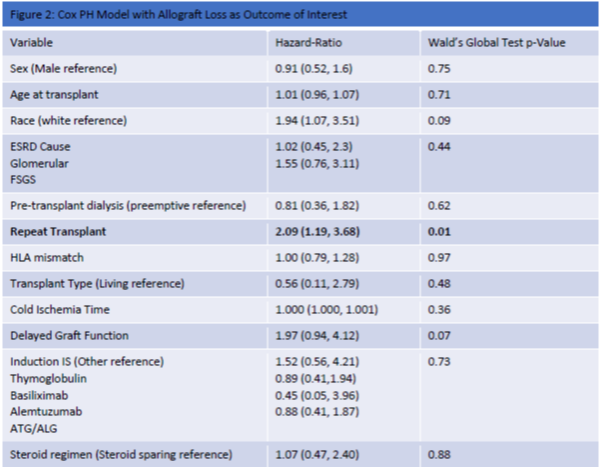Comparing Long-Term Outcomes of Steroid-Based versus Steroid-Avoidant Immunosuppression in Pediatric Kidney Transplant Recipients
1Montefiore Medical Center, Bronx, NY, 2Children's Hospital Colorado, Aurora, CO, 3Emmes Corporation, Rockville, MD, 4University of British Columbia, Vancouver, BC, Canada
Meeting: 2022 American Transplant Congress
Abstract number: 106
Keywords: Immunosuppression, Kidney transplantation, Outcome
Topic: Clinical Science » Kidney » 43 - Kidney: Pediatrics
Session Information
Session Time: 5:30pm-7:00pm
 Presentation Time: 5:50pm-6:00pm
Presentation Time: 5:50pm-6:00pm
Location: Hynes Ballroom C
*Purpose: With increasing use of potent immunosuppressant (IS) medications, steroid-avoidant (SA) regimens are now commonly used for pediatric kidney transplant recipients (pKTs) to avoid potential long-term corticosteroid (CS) effects. Yet, long-term impact of SA regimens in pKTs has not been characterized. We hypothesize that modern era, SA-IS protocols present specific advantages for pKTs without compromising allograft outcomes.
*Methods: We performed a retrospective analysis of the North American Pediatric Renal Trials and Collaborative Studies (NAPRTCS) database for all pKTs (ages 0-18 years) performed from 2000-2019. Participants were stratified by CS therapy: SA (no CS at 30 days post-KT or steroid-based (SB; CS use at 30 days post-KT). Categorical variables were compared using a chi-square test; continuous variables were compared using a Kruskal-Wallis test. A Cox proportional hazards (PH) model analyzed independent predictors of graft survival. Primary outcome measures included KT function and survival at 1, 3 and 5 years. Secondary outcomes included: growth and blood pressure (BP) control.
*Results: 3218 pKTs were included in the analysis with 732 (22.7%) SA compared to 2486 (77.3%) on SB therapy. The eGFR delta from baseline was significantly lower in the SB group at 1-, 2-, 3- and 5-years post-KT. The Kaplan-Meier curve (Figure 1) showed worse graft survival with SB regimens (p=0.02). However, the Cox PH model (Figure 2) found only repeat renal transplant [hazard ratio (HR): 2.09 (1.19, 3.68)] to be an independent predictor of graft loss. Height z-score was significantly lower in the SB group at 1- (p=0.0001), 2- (p=0.0003), 3- (p=0.0084) and 5-years (p= 0.03) post-KT. CS therapy was associated with higher body mass index (BMI) percentiles at 1- and 3-years post-KT. There was no association between CS and BP.
*Conclusions: SA-IS yields equivalent, or potentially improved, long-term graft and patient outcomes for pKTs. Moreover, undesired side-effects of longitudinal CS therapy can be avoided.
To cite this abstract in AMA style:
Hayde N, Blanchette E, Zhang J, Chandran M, Bock M, Galbiati S, Blydt-Hansen T. Comparing Long-Term Outcomes of Steroid-Based versus Steroid-Avoidant Immunosuppression in Pediatric Kidney Transplant Recipients [abstract]. Am J Transplant. 2022; 22 (suppl 3). https://atcmeetingabstracts.com/abstract/comparing-long-term-outcomes-of-steroid-based-versus-steroid-avoidant-immunosuppression-in-pediatric-kidney-transplant-recipients/. Accessed December 17, 2025.« Back to 2022 American Transplant Congress


